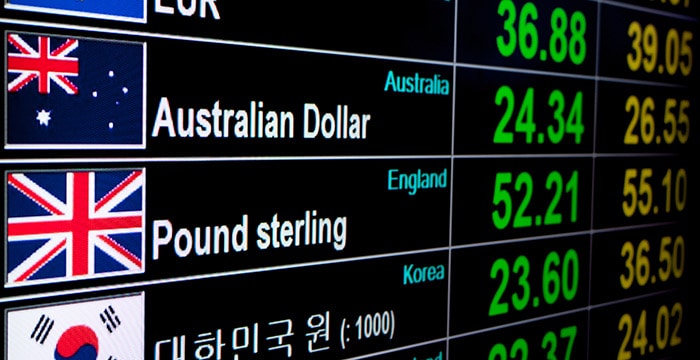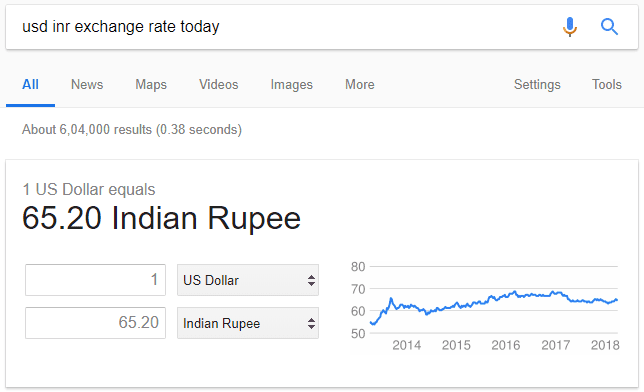
Have you ever wondered why the value of the US Dollar keeps fluctuating against the Indian Rupee? If you have wanted to buy forex sometime or were simply curious then you would have searched in google something like this;

Who determines exchange rates in India?
Nobody. Well to be more precise, no single institution or organization determines the exchange rate of rupee at present, not even the RBI. Rather, the exchange rate of rupee with foreign currencies is determined by a combination of market factors. But this wasn’t the case always.
RBI determined the exchange rate of rupee pre-1990s
Prior to the period of economic liberalization in the 1990s, India followed a fixed exchange rate system. The Indian rupee was pegged to the US dollar and a basket of other currencies. In pegging, the value of a currency is fixed in a predetermined ratio to another more stable and internationally used currency or to a bunch of such currencies. Fixed exchange rate does not mean the value of the currency will not change. It means that the value of the currency will move in tandem with the currency or currencies to which it is pegged i.e. the ratio of the value of the currencies will be maintained. The exchange rate will not change every day but it may be reset on particular dates known as revaluation dates. In this economic system, the government or the RBI is the authority which ensured the exchange rate of the rupee is fixed with respect to other currencies.
How did the RBI ensure fixed exchange rates pre-1990s?
The value of a currency, just like any other commodity, is determined by supply and demand. The supply of a currency and its demand in the market. Let us consider the example of USD – INR pair to understand this better.
The RBI maintained a reserve of US dollars to ensure fixed exchange rate. When the demand for US dollars was high, its value appreciated with respect to the rupee. To counter this, RBI would pump US dollars into the market from its reserve to meet the demand and thereby bring down the appreciating value of the dollar. Similarly, if the rupee was appreciating with respect to the dollar, then to maintain the peg (fixed exchange rate) RBI would sell the rupee to buy US dollar to bring down its value.
Other monetary instruments were also used to maintain the fixed exchange rate but talking about them would be out of the scope of this discussion. So to put it simply, by playing a direct hand in the supply and demand process RBI used to maintain the fixed exchange rate.
This brings us to the next question…
What made RBI discontinue the fixed exchange rate system?
When a country pegs its currency to another country’s currency, it loses the ability to shape an autonomous monetary policy according to its prevailing economic conditions. This is one of the main reasons RBI discontinued fixed exchange rate.
Here is an interesting example. In 1997, the Thai baht was pegged to the US dollar at an exchange rate of 25 baht to 1 dollar. The same year, the Asian financial crisis was experienced by 6 countries! Starting from Thailand the crisis spread to Malaysia, Singapore, Indonesia, Philippines and South Korea. As Thailand was facing economic problems, the baht was going down in value. People were rushing to buy US dollars by converting their baht. In an effort to maintain the exchange rate, the Thai government started selling its reserve of US dollars. Eventually, they ran out of dollars and the peg snapped on 30th June 1997 and the baht was in free fall.
If only Thailand had a floating exchange rate system instead of fixed exchange rate (which they adopted later), they could have altered their monetary policy to meet the changing economic conditions and ensure healthy growth of the economy.
India too faced a situation back in 1992. RBI almost ran out of its dollar reserve and was close to being unable to maintain the peg. It was during this period that sweeping economic reforms were made and the floating exchange rate was gradually adopted.
So now that you are clear on how the currency exchange rates were set in the past, let’s take a look at how they are set in the present.
How are currency exchange rates determined in India?
We already mentioned that no single authority or institution sets the exchange rates in India. India has a floating exchange rate system where the exchange rate of the rupee with another currency is determined by market factors such as supply and demand.
For example: If the demand for US dollars increases in the forex market, the value of the dollar will appreciate. This is the case currently as more goods are imported to India from the US than exported to the US from India. The local Indian traders need to pay for the imported goods in US dollars. Thus they buy US dollar by exchanging it for the rupee which increases the demand for USD and helps it to appreciate with respect to the rupee.
Apart from supply and demand, the following 5 factors are widely agreed upon as being the driving force determining the exchange rate of a currency ;
1. Inflation in the country

Image Source : whitneyeconomics.com
You may have heard the older generation complaining about price rise. The price of goods or services will increase if they become rare (less supply, same or increased demand) or if money is in greater supply in the economy. This is what is called inflation. Inflation brings about a fall in purchasing power of the currency and thus its value.
2. Interest rate or repo rate
Interest rate of India is currently set at 6% and is decided by the RBI. It is the rate at which RBI lends money to the banks in India. A higher interest rate would mean investors would rush to buy government bonds as the returns would be higher. The rupee will be in more demand and its value will increase.
However, the downside of a higher interest rate would be that when banks are lending the money to people, they would charge an even higher interest rate than what RBI charges them, to make a profit on their loans. This might discourage people who want to start a business or take a loan to buy a house, car, or for their education. Without the flow of capital in the form of loans, the economic activity of a country may get stifled and slowed down.
3. Level of current account deficit
A current account represents a country’s foreign transactions. Current account deficit implies that a country is spending more money on importing goods and service from abroad than earning money via exports. Since importing of goods and service is more than exporting, and imports have to be paid in foreign currency, this increases the demand for that currency and hence its value appreciates with respect to the rupee. If the vice versa was the case where exports are greater than imports, then the value of the rupee will appreciate with respect to the foreign currency.
4. Import and export of gold
We talked about the effect of the current account deficit on exchange rate above. When a country imports goods more than it exports, the value of its currency gets lowered.
One direct impact of it can be seen in India in the case of importing gold.
Did you know that India is the largest importer and holder of gold in the world?! It is estimated that the people here hold up to 25,000 tons of gold.
Countries that excel in making a variety of products with gold but which don’t have large gold reserves themselves end up importing high quanitites of gold. Such countries will be generally having a weaker currency.
When the price of gold increases in the international market, the strength of the Indian rupee would accordingly go down.
5. Amount of public debt
If a country has a high level of budget deficits and is borrowing to cover this cost, then it would result in lower currency valuation. How does this happen? A country with a huge amount of public debt carries a very high risk of inflation. It must either print new currency to pay off its debts (which again increases inflation) or increase the sale of securities to foreign investors, hence lowering their prices. If the debt is too large and investors are not confident in the country’s ability to pay back its debts, then they will not be willing to buy securities denominated in that currency. Thus inflation will go up and currency valuation will go down.
6. Stability and economic growth
Where do you think foreign investors will put their money? In a war-torn country with no government, no economic policy and a destroyed economy or in a stable, strong and developing economy like India’s?
Foreign investors are looking to profit from their investments. Hence it is important for a country to a have a stable government and sound economic policies to attract investments. More foreign investments imply higher demand for the rupee and hence its price will appreciate.
As you can see from the points above, at present, the currency exchange rates in India are determined by market forces as India follows a floating exchange rate system rather than a fixed exchange rate system.
We hope you found this article informative and engaging. Stay tuned to our blog for more such interesting posts!
Also Read: Was 1 Rupee Really Equal To 1 USD In 1947?

Subhash is the head of content at Extravelmoney.com. Subhash’s contributions to content involve demystifying complex financial topics like currency exchange and international money transfers, making them accessible and engaging for a wide audience. His efforts are integral to ExTravelMoney’s mission of providing transparent and convenient financial solutions.
